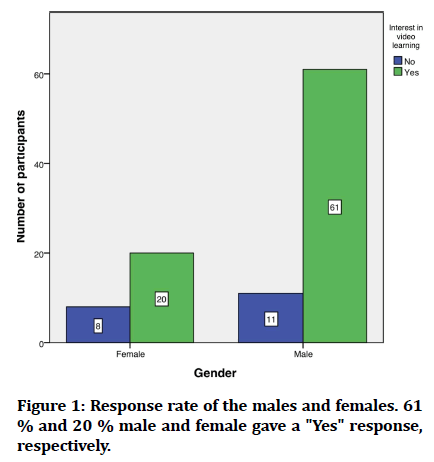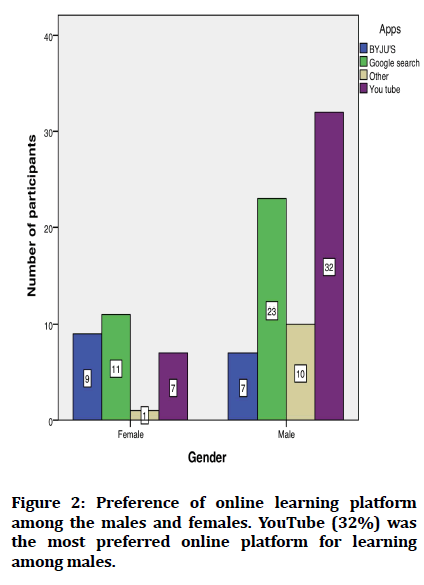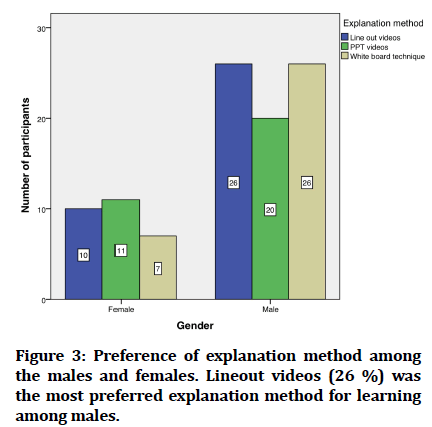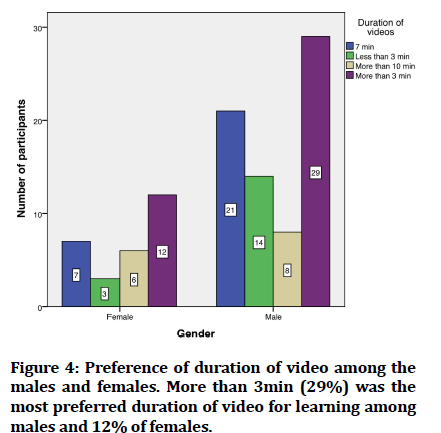Research - (2022) Volume 10, Issue 1
Role of Video Aids in Learning among Higher Education Students: An Observational Study
Ganesh S, Palati sinduja* and R Priyadharshini
*Correspondence: Palati sinduja, Department of of Pathology, Saveetha Dental College, Saveetha Institute of Medical and Technical Sciences (SIMATS), Saveetha University, Chennai, India, Email:
Abstract
Introduction: Video-based learning is a form of eLearning that allows its audience to acquire skills and gain knowledge via video. This method of training is becoming increasingly popular, and starting to replace the traditional. They improve learner performance by providing visual examples, allowing them to interact, explore and digest the content at their own pace. The aim is to find the role of video aids for learning among the students of higher education. Materials and methods: A simple online survey was carried out to investigate the role of video aids for learning among the students of higher education. 15 self-explanatory questions were framed and distributed to the participants through an Online google forms link. The data collected in google sheets were transferred to SPSS software. Descriptive statistics and Chi- square were carried out. Result: The study shows 81% of students are interested in video learning. Most of the males prefer audio quality but females prefer visual content of the video. We observed that 36% of the participants preferred Line out videos and 31% of them preferred ppt videos. Most of the students use YouTube for learning, it provides free access to a huge volume of educational videos. This service allows users to watch videos and post comments and allows registered users to upload videos. 41% of students prefer the duration of the video to be less than 7 min. 32% of students prefer fast explanation in the video and 51% prefer the normal level of speed in video. Conclusion: The video aids were found to be very useful to students in learning. preference for video aid for learning is high among students if the video has good audio quality, visual resolution and simple methods of explanation. The study found that video length impacts their viewing decision of students indicating that length should play a factor in video learning. The video aids have their own advantages as well as their disadvantages, which should be considered when choosing the video aids.
Keywords
Video aids, E-learning, Visual content, Video learning, Innovative technique
Introduction
Video-based learning is a widely-accepted e-learning trend. Video learning is one of the graphical elements of the online learning experience, which enhances the understanding level of the material. Online courses that utilise media-rich educational aids, audio-visual forms for teaching and learning of both knowledge content and skill [1]. Video conferencing has been used successfully for distant learning and has the advantage of offering mediarich audio and visual stimulation covering a wider spectrum of learning styles [2]. Video can be forward, rewind and repeatedly viewed allowing users to use the content within their own time at their place. videos can obtain the maximum benefit from the limited staff resources. As internet access has become available everywhere, online educational resources have become commonplace which replaces more traditional teaching methods However, the development and production of videos can be costly and labour intensive. Creating videos is more time consuming than the production of traditional educational materials such as lectures. Further technical expertise is required on the part of the designer [3]. Learning is now more independent and interactive as a result of these developments. The use of videos allows students to view techniques with realistic and allow for a richer communication of information that is not present in some of the more traditional teaching resources [4]. Many educators and researchers have proved videos are an important tool for providing the contents and starting point for learning. Videos provide good digitized images, text and sound that can be uploaded to a shared community [5]. Today’s children are spending a considerable amount of their time online. At the same time, these developments increase the basic requirements of the schools’ educational programs.
Recent work done on YouTube shows the use of YouTube provides free access to a huge volume of educational videos. This service allows users to watch videos and post comments and allows registered users to upload videos [6]. The study done on students at the University of Ghana towards the use of videos as a medium for teaching and learning shows almost all the participants reported that they had problems with the format of all the videos they watched and the content. But, the majority of the participants perceived that the videos they watched enhanced their learning outcomes and improved their learning approach [7]. The study done by [8]. on the impact of educational videos shows students prefer good quality videos and audios for long-term listening of the videos.
Most of the previous studies were done based on video education in the classroom and video podcast impacts, problems and learning process. However, there is no consensus among the various teaching faculties regarding the teaching tool. Our team has extensive knowledge and research experience that has translated into high quality publications [9-28]. The aim of the study is to know the role of video aids for learning among the students of higher educational institutes.
Materials and Methods
Study setting
It is a prospective observational study. The study was approved by the scientific review board of the institute.
Patient selection and recruitment
The cross-sectional descriptive survey was conducted among 100 college students from Saveetha Dental College. Undergraduate students of 18-22 years, both males and females were included in this and the age group beyond the criteria were excluded.
Development of questionnaire
Structured questionnaire consisted of 15 selfexplanatory questions which were validated by conducting a pilot study containing 5 male and female students. Final structured questionnaire was converted into an online survey form using Microsoft google form. The google form was sent to prospective participants and were asked to provide a response for each of the questions. The participants were contacted through phone after sending the online form as well as in case of delay in response. The study was approved by the Institutional review board.
Parameter studied
Survey (Data collection)
This was conducted through an online survey in one month in February 2021. The responses were collected in the google sheet and tabulated. The results were obtained and analysed using statistical software.
Parameter/Outcome
The dependent variables include student’s knowledge, and the independent variables are gender, weight, height, and course, year of study.
Statistical analysis
The descriptive statistics were done using IBM SPSS V22 software. Gender and age were dependent variables and knowledge, perception were independent variables. Chisquare analysis was performed for gender association and p<0.05 was considered as statistically significant. The statistical test used was the student T test.
Results
The study shows 81% of students are interested in video learning. The majority of males and females have preferred learning through video aids, however, there was no statistical significance between gender (P=0.128). 61% male and 20% of females are interested in video learning, 11% of male and 8% of females are not interested in video learning. Figures 1 and 2 shows the majority of male have answered YouTube and females have answered google search but in analysis, there was no statistical significance between gender and responses about the choice of apps for video learning (p value=0.014). 32% of the males use YouTube but females use google to search for their learning. Among males 23% use google search, 7% use Byju’s. Among females, 7% use YouTube and 9% use Byju's for learning. Figure 3 shows the majority of male have answered line out videos and females have answered PPT videos but in analysis, there was no statistical significance between gender and responses about the choice of apps for video learning (p value=0.446). 26% of male prefer line out videos and whiteboard techniques but females mostly prefer PPT videos. Among males, 20% prefer PPT videos. Females 10% and 7% prefer line out and whiteboard videos. The majority of male and females answered more than 3 min but in analysis, there was no statistical significance between gender and responses about the choice of apps for video learning (p value=0.458) (Figure 4). Male 29% prefer video duration of more than 3min, 21% prefer a video duration of 7 min, 14% prefer video duration less than 3 min. Females 12% prefer video duration of more than 3 min, 7% prefer video duration 7 min. 6% prefer a video duration of less than 7 min. The majority of male and females answered normally but in analysis, there was no statistical significance between gender and responses about the choice of apps for video learning (p value=0.356). Males 37% prefer the normal speed of the video, 25% prefer the faster speed of videos, 10% prefer the slower speed of the video (Figure 5). Females 14% prefer the normal speed of the video, 7% prefer the faster and slower speed of the video. This shows that most everyone prefers the normal speed of videos. 22% of males prefer audio quality but females 10% prefer visual content (Figure 6). Among males 18% prefer visual content, 12% prefer fast loading videos, 20% prefer visual resolution. Females 5% prefer audio quality, 7% prefer fast loading and 6% prefer visual resolution. 38% of male have medium levels of satisfaction, 26% have high levels of satisfaction, and 8% have low levels of satisfaction (Figure 7). Females 10% have medium levels of satisfaction, 11% have high levels of satisfaction, 7% have low levels of satisfaction. 51% of male and 24% of females are interested in note taking (Figure 8). 21% of males and 4% of females are not interested in note-taking. male 29% watch 3 videos in 1 hour, 17% watch 2 videos in 1 hour. Females 10% watch 3 videos in 1 hour, 8% watch 1 video in 1 hour (Figure 9). 33% of the male can pay 10 min attention, 25% can pay 5min attention, 9% can pay more than 10 min attention (Figure 10). Females 11 can pay 10 min attention, 6% can pay 5 min attention.

Figure 1: Response rate of the males and females. 61 % and 20 % male and female gave a "Yes" response, respectively.

Figure 2: Preference of online learning platform among the males and females. YouTube (32%) was the most preferred online platform for learning among males.

Figure 3:Preference of explanation method among the males and females. Lineout videos (26 %) was the most preferred explanation method for learning among males.

Figure 4:Preference of duration of video among the males and females. More than 3min (29%) was the most preferred duration of video for learning among males and 12% of females.

Figure 5:Preference of speed of video among the males and females. normal (37% was the most preferred duration of video for learning among males and 14% of females.

Figure 6:Bar chart showing the association between gender and the responses on important aspects of videos. X axis represents gender and Y axis represents the number of participants. The majority of male have answered audio quality and females have answered visual content but in analysis, there was no statistical significance between gender and responses about the choice of apps for video learning. Chi-square value=3.870, p value=0.144 (p>0.05 statistically not significant).

Figure 7:Bar chart showing the association between gender and the level of the responses of satisfaction. The majority of male have answered medium and females have answered high but in analysis, there was no statistical significance between gender and responses about the choice of apps for video learning. Chi-square value=3,870, p value=0.144 (p>0.05 statistically not significant).

Figure 8:Bar chart showing the association between gender and the responses about interest in notes taking. The majority of male and females have answered yes but in analysis, there was no statistical significance between gender and responses about interest in video learning. Chi-square value=2.381,p value=0.123 (p>0.05 statistically not significant).

Figure 9:Bar chart showing the association between gender and the responses to the number of videos. The majority of male and females have answered 3 videos but in analysis, there was no statistical significance between gender and responses about the choice of apps for video learning. Chi-square value=0.984, p value=0.805 (p>0.05 statistically not significant).

Figure 10:Bar chart showing the association between gender and the responses on attention duration. The majority of male and females answered 10 min but in analysis, there was no statistical significance between gender and responses about the choice of apps for video learning. Chi-square value=5.604, pvalue= 0.133 (p>0.05 statistically not significant).
Discussion
Hamdan AK et al shows Participating students were found to be most likely to visit YouTube from a mobile device. The accessibility of YouTube by students through mobile devices is significant [29]. Fong KK et al shows Online procedural videos as learning resources had a small but positive effect on objective structured clinical examination performance for a group of postgraduate students [30]. Sherman J et al shows the use of different audio-visual materials makes the class interesting and enjoyable [31]. The use of different types of interesting videos can take away the monotony of the students as they make learning more attractive and attentive. Visual aids help the learners to learn a language in diversified ways. The audio clip helps them to learn the correct pronunciation. Reka et al shows Visual aids impact and adds interest to a presentation. They can create excitement. Visual aids enable students to use more than one sense at the same time [32]. Parsons et al found that audio-visual materials can make lessons easy to understand. Images that learner views on the screen can be easily comprehended and remembered than descriptive reading materials. Learners feel that they can remember the information for a longer duration due to the use of audio-visual aids. Therefore, having something visual in the lesson is always helpful for the learners [33]. Zhao Y et al expressed both preferences of a short and long length of videos through qualitative feedback from students and supported by experimental design too. Shorter videos are found to be more engaging, increasing learning outcomes [34]. Harden et al. and influence students’ decisions to use video again for future learning [35]. The benefits of video increasing access to practical demonstrations. Students can learn from field experts and with the option to view them repeatedly if necessary[36]. Borup et al. shows video learning has the risk of isolation and lack of self-motivation Computer anxiety is found to be a key factor affecting learner satisfaction in elearning. Video-based communication methods can be used as a tool through which to interact and assess student performance and comprehension [37].
The findings of this study have to be seen in light of some limitations. Sample size of study was a small and particular group of students were surveyed.
Conclusion
The video aids were found to be very useful to students in learning. preference for video aid for learning is high among students if the video has good audio quality, visual resolution and simple methods of explanation. The study found that video length impacts their viewing decision of students indicating that length should play a factor in video learning. The video aids have their own advantages as well as their disadvantages, which should be considered when choosing the video aids.
Acknowledgement
The authors are thankful to Saveetha Institute of Medical and Technical Sciences, Saveetha Dental College and Hospitals, Saveetha University for giving a platform to conduct the study.
Source of Funding
The present project is supported by:
• Saveetha Dental College and Hospitals, Saveetha University, Saveetha Institute of Medical and Technical Sciences, India
• Royal Hospital, Thanjavur.
References
- Jones RB. Use of live interactive webcasting for an international postgraduate module in ehealth: Case study evaluation. J Med Internet Res 2009; 11:e46.
- Abdallah AR, Al-Zalabani A, Alqabshawi R. Preferred learning styles among prospective research methodology course students at Taibah University, Saudi Arabia. J Egypt Public Health Assoc 2013; 88:3-7.
- Makkiya E, Al-Hemiary EH. Impact of video transcoding profiles in wireless multicast streaming. In International Conference on Future Communication Networks 2012; 111-116.
- Morain M, Swarts J. You Tutorial: A framework for assessing instructional online video. Tech Communication Quarterly 2012; 21:6-24.
- Cennamo KS. Learning from video: Factors influencing learners' preconceptions and invested mental effort. Educ Technol Res Develop 1993; 41:33-45.
- Koh K. The use of video technology in pre-service teacher education and in-service teacher professional development. Cases of Mathematics Professional Development in East Asian Countries 2015; 229–47.
- Boateng R, Boateng SL, Awuah RB, et al. Videos in learning in higher education: Assessing perceptions and attitudes of students at the University of Ghana. Smart Learning Environ 2016; 3:1-3.
- https://iacis.org/iis/2020/3_iis_2020_126-134.pdf
- Anita R, Paramasivam A, Priyadharsini JV, et al. The m6A readers YTHDF1 and YTHDF3 aberrations associated with metastasis and predict poor prognosis in breast cancer patients. Am J Cancer Res 2020; 10:2546–54.
- Jayaseelan VP, Paramasivam A. Emerging role of NET inhibitors in cardiovascular diseases. Hypertens Res 2020; 43:1459–61.
- Sivakumar S, Smiline Girija AS, Vijayashree Priyadharsini J. Evaluation of the inhibitory effect of caffeic acid and gallic acid on tetR and tetM efflux pumps mediating tetracycline resistance in Streptococcus sp., using computational approach. J King Saud University Sci 2020; 32:904–9.
- Smiline Girija AS. Delineating the immuno-dominant antigenic vaccine peptides against gacs-sensor kinase in Acinetobacter baumannii: An in silico Investigational Approach. Front Microbiol 2020; 11:2078.
- Iswarya Jaisankar A, Smiline Girija AS, Gunasekaran S, et al. Molecular characterisation of csgA gene among ESBL strains of A. baumannii and targeting with essential oil compounds from Azadirachta indica. J King Saud University Sci 2020; 32:3380–7.
- Girija ASS. Fox3+ CD25+ CD4+ T-regulatory cells may transform the nCoV’s final destiny to CNS! J Med Virol 2020.
- Jayaseelan VP, Ramesh A, Arumugam P. Breast cancer and DDT: Putative interactions, associated gene alterations, and molecular pathways. Environ Sci Pollut Res Int 2021; 28:27162–73.
- Arumugam P, George R, Jayaseelan VP. Aberrations of m6A regulators are associated with tumorigenesis and metastasis in head and neck squamous cell carcinoma. Arch Oral Biol 2021; 122:105030.
- Kumar SP, Girija AS, Priyadharsini JV. Targeting NM23-H1-mediated Inhibition of tumour metastasis in viral hepatitis with bioactive compounds from ganoderma lucidum: A computational study. Indian J Pharm Sci 2020; 82:300-5.
- Girija SA, Priyadharsini JV, Paramasivam A. Prevalence of carbapenem-hydrolyzing OXA-type β-lactamases among Acinetobacter baumannii in patients with severe urinary tract infection. Acta Microbiol Immunol Hung 2019; 67:49–55.
- Priyadharsini JV, Paramasivam A. RNA editors: Key regulators of viral response in cancer patients. Epigenomics 2021; 13:165–7.
- Mathivadani V, Smiline AS, Priyadharsini JV. Targeting epstein-barr virus nuclear antigen 1 (EBNA-1) with Murraya koengii bio-compounds: An in-silico approach. Acta Virol 2020; 64:93–9.
- Girija AS, Priyadharsini JV. Prevalence of Acb and non-Acb complex in elderly population with urinary tract infection (UTI). Acta Clin Belg 2021; 76:106–12.
- Anchana SR, Girija SAS, Gunasekaran S, et al. Detection of csgA gene in carbapenem-resistant Acinetobacter baumannii strains and targeting with Ocimum sanctum biocompounds. Iran J Basic Med Sci 2021; 24:690–8.
- Girija ASS, Shoba G, Priyadharsini JV. Accessing the T-Cell and B-Cell immuno-dominant peptides from A. baumannii biofilm associated protein (bap) as vaccine candidates: A computational approach. Int J Pept Res Ther 2021; 27:37–45.
- Arvind P TR, Jain RK. Skeletally anchored forsus fatigue resistant device for correction of Class II malocclusions-A systematic review and meta-analysis. Orthod Craniofac Res 2021; 24:52–61.
- Venugopal A, Vaid N, Bowman SJ. Outstanding, yet redundant? After all, you may be another Choluteca Bridge! Semin Orthod 2021; 27:53–6.
- Ramadurai N, Gurunathan D, Samuel AV, ET AL. Effectiveness of 2% articaine as an anesthetic agent in children: Randomized controlled trial. Clin Oral Investig. 2019; 23:3543–50.
- Varghese SS, Ramesh A, Veeraiyan DN. Blended module-based teaching in biostatistics and research methodology: A retrospective study with postgraduate dental students. J Dent Educ 2019; 83:445–50.
- Mathew MG, Samuel SR, Soni AJ, et al. Evaluation of adhesion of Streptococcus mutans, plaque accumulation on zirconia and stainless steel crowns, and surrounding gingival inflammation in primary molars: randomized controlled trial. Clin Oral Investigations 2020; 24:3275–80.
- Hamdan AK. Teaching and learning in Saudi Arabia: Perspectives from higher education. Springer 2015; 226.
- Fong KK, Gilder S, Jenkins R, et al. The influence of online video learning aids on preparing postgraduate chiropractic students for an objective structured clinical examination. J Chiropr Educ 2020; 34:125–31.
- Sherman J. Using authentic video in the language classroom. Cambridge University Press 2003; 277.
- Réka M. Using visual aids in english teaching: “Teaching vocabulary” with the use of visual aids. 1994; 77.
- Parsons D. Mobile and blended learning innovations for improved learning outcomes. IGI Global 2016; 366.
- Li M, Zhao Y. Exploring learning & teaching in higher education. Springer 2014; 410.
- Gee JP, Hayes ER. Language and learning in the digital age. Routledge 2011; 168.
- Weiss RE, Knowlton DS, Speck BW. Principles of effective teaching in the online classroom. New directions for teaching and learning. The jossey-bass higher and adult education series. Jossey-Bass Publishers 2000.
- Borup J, Graham CR, Velasquez A. The use of asynchronous video communication to improve instructor immediacy and social presence in a blended learning environment. In Blended learning across disciplines: Models for implementation 2011; 38-57.
Indexed at, Google Scholar, Cross Ref
Indexed at, Google Scholar, Cross Ref
Indexed at, Google Scholar, Cross Ref
Indexed at, Google Scholar, Cross Ref
Indexed at, Google Scholar, Cross Ref
Indexed at, Google Scholar, Cross Ref
Indexed at, Google Scholar, Cross Ref
Indexed at, Google Scholar, Cross Ref
Indexed at, Google Scholar, Cross Ref
Indexed at, Google Scholar, Cross Ref
Indexed at, Google Scholar, Cross Ref
Indexed at, Google Scholar, Cross Ref
Indexed at, Google Scholar, Cross Ref
Indexed at, Google Scholar, Cross Ref
Indexed at, Google Scholar, Cross Ref
Author Info
Ganesh S, Palati sinduja* and R Priyadharshini
Department of of Pathology, Saveetha Dental College, Saveetha Institute of Medical and Technical Sciences (SIMATS), Saveetha University, Chennai, IndiaReceived: 13-Dec-2021, Manuscript No. JRMDS-21-41701; , Pre QC No. JRMDS-21-41701 (PQ); Editor assigned: 15-Dec-2021, Pre QC No. JRMDS-21-41701 (PQ); Reviewed: 29-Dec-2021, QC No. JRMDS-21-41701; Revised: 03-Jan-2022, Manuscript No. JRMDS-21-41701 (R); Published: 10-Jan-2022
